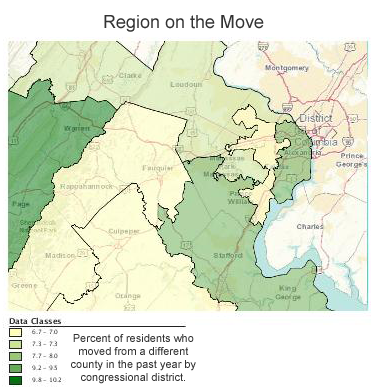WASHINGTON — The changing faces of Northern Virginia will have a big impact on the 2016 presidential race and two political professionals see a lot of work and commercials ahead between now and November.
“Yeah, look, it’s gotten harder,” veteran Virginia Republican operative Tucker Martin says.
Changing demographics have brought more traditionally Democratic supporters to the growing Northern Virginia region as more heavily Republican parts of the state are not growing, or not growing nearly as quickly.
Northern Virginia grew by more than 500,000 residents between 2000 and 2010. But new Hispanic and Asian residents fueled most of the growth, according to the Center for Regional Analysis at George Mason University.
The Hispanic population grew 35 percent and the Asian community grew 26 percent, according to the center.
“It’s more favorable for Democrats, but it’s not impossible for Republicans. We have to do a better job at persuasion,” Martin says.
He and Democratic strategist Ellen Qualls spoke together to reporters earlier this month.
“If you’re not really exciting your base, you’re not winning in Virginia, and that’s a huge change,” she says.
Qualls has worked on a number of statewide races in Virginia as well as President Barack Obama’s campaign.
“It’s always a jump ball, and I think my old boss Mark Warner proved that in his last senate race. And so I think the way we swing is based more on organization, mechanics, money and what excites people,” she says.

“Whatever campaign most successfully finds wherever that community gathers — be it a local mosque or whatever — and actually has credible on-the-ground spokespeople will really, I think, move the needle,” she adds.
Voter turnout in a presidential election year in Virginia is typically significantly higher than other years in the four-year cycle when the state elects a governor, legislature or members of Congress.
In 2012, 71.8 percent of registered Virginia voters turned out, compared to 43 percent during the governor’s race in 2013, 41.6 percent for the Senate and Congressional races in 2014 and just 29 percent in the November General Assembly election.
“You can say the demographics keep changing and that’s going to help Democrats, but then I wouldn’t be surprised if the next gubernatorial election is quite close,” Qualls says.
Martin served as Gov. Bob McDonnell’s spokesman, and now works for a political action committee that supports Chris Christie’s presidential run.
“If you just look at it on paper, you say as a Democrat strategist like [Qualls], this looks more positive for us. I see our voters here, I see the population trends. But as a Republican, I look at that and I think: OK, I mean, 7 million people lived in Virginia in 2000, like 8.3 million people live here now, we are an incredibly transient population so my party has to do a better job on finding these new voters and persuading them. And that’s a lot harder work,” he says.
In 2012, nearly all of Obama’s 149,298 margin of victory in Virginia came from Prince William and Fairfax counties.
Qualls says she believes the rhetoric she has heard from Republican candidates such as Donald Trump could help Democrats in the state.
“I find it shocking that you would leave Fairfax County and Loudoun County on the table because so many of your candidates just completely turn off immigrants,” she says.
But Martin says he believes Republicans can turn things around, citing the close 2014 race for U.S. Senate. Former Republican National Committee Chair Ed Gillespie narrowly lost to incumbent Sen. Mark Warner.
“As Republicans, do we need to do better with new communities? We absolutely do. But we’ve seen candidates do it,” he says.
Martin says he hopes Virginia follows his view of national trends and swings back to Republicans in 2016. He says a Republican cannot win the White House without winning Virginia.
“We’re all going to be really tired of TV ads come next November,” he says.







